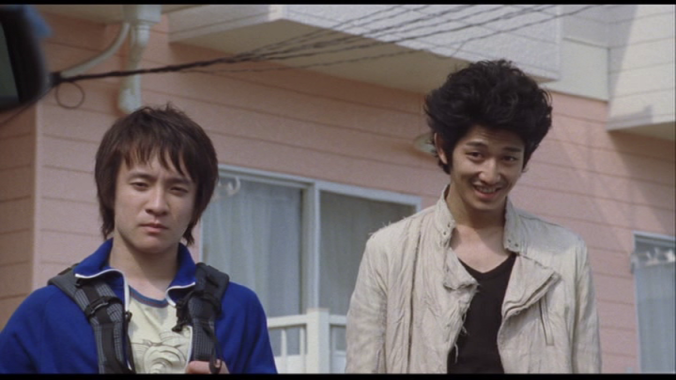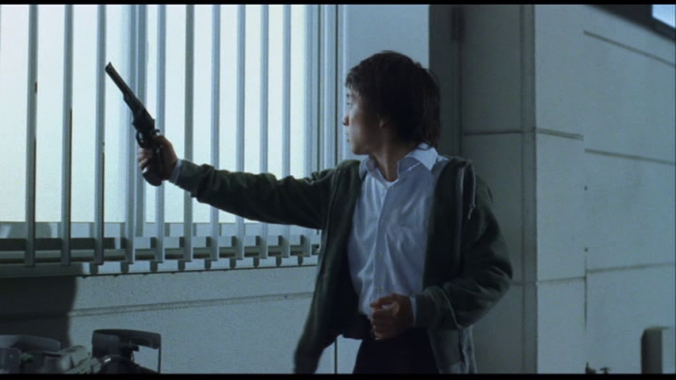 The God in the coin locker is Bob Dylan, whose “Blowin’ in the Wind” is used as a repeated motif in this most unexpected film. Shiina sings it on the train to his freshman year at one of the several universities to be found in Sendai, and the story itself often seems to be blowing in the wind.
The God in the coin locker is Bob Dylan, whose “Blowin’ in the Wind” is used as a repeated motif in this most unexpected film. Shiina sings it on the train to his freshman year at one of the several universities to be found in Sendai, and the story itself often seems to be blowing in the wind.
At first it takes some time to be sure he is at university. No one has ever looked more like a confused freshman than the openly fresh-faced actor Gaku Hamada,* who is also extremely short in comparison to the rest of the cast, including the women. It looks like we are in for a college comedy about a young man leaving home for the first time. But this is a Japanese movie, so although we see some of his early days of trying to figure out the university, the movie is really about something else, starting with his neighbors in his apartment building.
Reminded by his mother on the phone to introduce himself, he gets a gruff response from one neighbor but the one on the other side starts talking to him because he hears him singing the song while unpacking. Remarking that he was once told that Dylan was the voice of God, Kawasaki invites him inside. There he tells him that the other neighbor is Dorje, a student from Bhutan who doesn’t speak very good Japanese, but who also stole the heart of Kawasaki’s girlfriend Kotomi after he rescued a lost dog in traffic. He warns him to never believe anything told him by the pet store owner Reiko, whom Shiina has never met. Later at the school in search of textbooks he stops to talk to a mysterious woman at the fountain who turns out to be Reiko, who tells him never to believe what Kawasaki says.
Over the next few weeks, Shiina is told more detail about Kotomi and Dorje, and also about some maimings and killing of pets around the city which inexplicably stopped about 2 years before. He is also roped into a robbery of a bookstore to get a dictionary as a gift for Dorje in which Shiina is supposed to stand around the back window waving a toy pistol while Kawasaki commits the robbery. This looks like the beginning of a story about a naive young man caught up in someone else’s crimes, but that too is a deceptive start.
This looks like the beginning of a story about a naive young man caught up in someone else’s crimes, but that too is a deceptive start.
As Shiina visits the pet shop and talks a bit more with Reiko and as Kawasaki explains more of the story of Dorje and Kotomi, things seem to become a bit more clear, until Shiina notices that Kotomi is nowhere to be found at the pet shop. A photo taken at the zoo that is first seen with only two people is opened to show it contains three and Reiko and Shiina follow Kawasaki on a mysterious night trip into the woods. Suddenly everything changes again, and we start the story over with new information. This is not a Rashomon story, with each character telling a different story, but rather a gradual retelling, with each telling providing more information until we realize that nothing was as it seemed when we first saw it. Though adapted from a novel by the popular mystery writer Kotoro Isaka, it is hard to categorize Foreign Duck as a traditional mystery. Looking back from the ending, we can see that we were given many clues, but they were never given as clues per se. Shiina is never trying to solve a mystery, and it is only after the mystery is “solved” that we realize we were in a crime story at all.
This makes it very difficult to talk about the movie in any more detail, but suffice it to say that nothing is as it seems to be when Shiina first arrives. Though it often appears to be gently ambling along, it turns out to be quite tightly organized. It also is far more complex than we would expect a typical mystery to be.
The title comes from a question asked by Dorje: Why do the Japanese have different names for a duck native to Japan and for one originally from other places? Metaphorically, then, it becomes a question about why a foreigner is seen as foreign, no matter how effectively he might assimilate, demonstrated vigorously by our changing perception of both Dorje and Kawasaki. On yet another layer, it is a question about the true nature of a person: Who or what is the real Kawasaki, the real Dorje, or for that matter, the real Shiina? It is also a question about the nature and value of life. For Dorje, Buddhism is his life blood, while the modern Japanese only seem to go through the motions of Buddhism. He protects Kotomi by throwing stones at their pursuers (who are the animal killers) but he is traumatized because bringing harm to another human being will hurt his karma. Kotomi tries to solve the problem for him by locking her Dylan CD in a cabinet; since Dylan is the voice of God, the karma is still safe as long as God can not see him. To help free Dorje from his ultimate dilemma, Shiina too will lock his portable CD player in a train station locker, where Dylan will sing “Blowin’ in the Wind” forever, or at least till the batteries die, leaving Dorje safe from God’s view no matter what he decides to do. Whether this works we are never told.
* Six years after this, Hamada would play a 12-year-old in Minasan, sayonara.
Pingback: Noriko’s Dinner Table (2006) | Japanonfilm